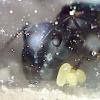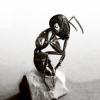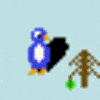Hi, thanks for your welcomes.
Snow is maybe a sensitive topic now for some of you, but for me snow is one way to do wood ant observations during winter. Because the ants, in this case Formica polyctena, isolate their nests very well, the warmth stays in. So, their dome keeps cooler than its surroundings. The effect is that when temperature is around zero, snow on the nests lasts longer.
In this case the snow tells me that this nest is populated, without seeing any ant.

Edited by Arjan van den Bosch, January 28 2015 - 4:27 AM.






















